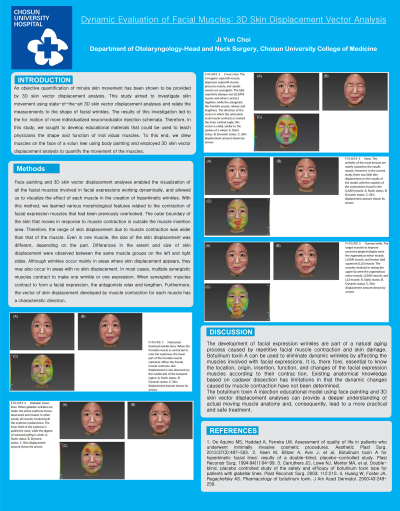Facial Plastic and Reconstructive Surgery
(150) Dynamic Evaluation of Facial Muscles: 3D Skin Displacement Vector Analysis
Monday, October 2, 2023
2:45 PM - 3:45 PM East Coast USA Time

Has Audio

Ji Yun Choi, MD
Professor
Chosun University Hospital
Gwangju, Kwangju-jikhalsi, Republic of Korea
Presenting Author(s)
Disclosure(s):
Ji Yun Choi, MD: No relevant relationships to disclose.
Introduction: Botulinum toxin A can be used to eliminate dynamic wrinkles by
relaxing the muscles involved in facial expressions. Therefore, it is essential to know
the location, origin, insertion, function, and changes of the facial expression muscles
according to their contraction.
Methods: After drawing the muscles on the face of a model, pictures were taken at
rest. The model was then asked to make facial expressions that cause facial wrinkles.
All images were taken with the Vectra H1 camera system (Canfield Scientific, Inc.,
Fairfield, New Jersey). Each expression image was aligned to its respective static
image to compute the differences in skin position, so as to calculate the skin displacement vectors. The values for local changes in skin displacement were calculated by
applying the automated algorithms of the Vectra Software Mirror Suite and visualized
using the color and size of the arrow.
Results: Face painting and 3D skin vector displacement analyses enabled visualization of all the facial muscles involved in facial expressions working dynamically, allowing us to visualize the effect of each muscle in the creation of hyperkinetic
wrinkles. Face painting and 3D skin vector displacement analyses can be combined
to determine the location of the wrinkles, extent of the muscle, part of the muscle
that contracts, presence of asymmetry, direction in which the muscle contracts, and
correlation between the antagonists and synergistic muscles.
Conclusions: The botulinum toxin A injection educational model using body painting
and 3D skin vector displacement analyses can provide a deeper understanding of
actual moving muscle anatomy.
